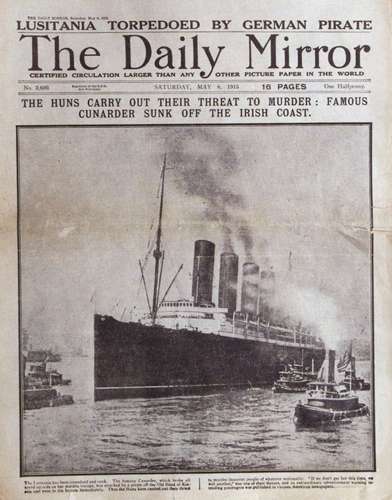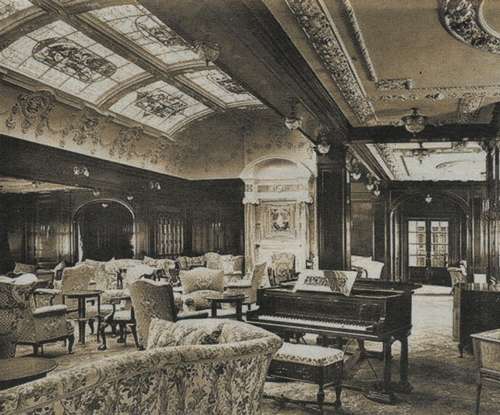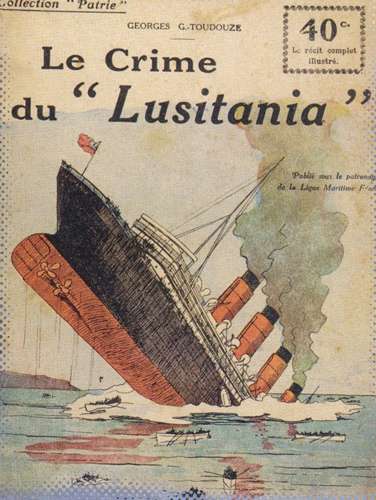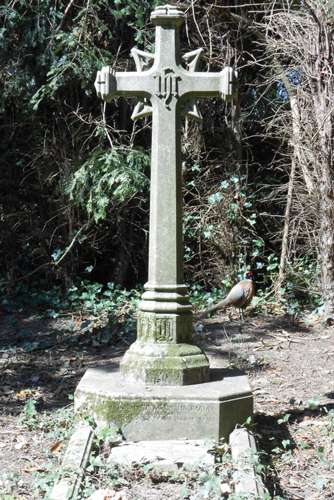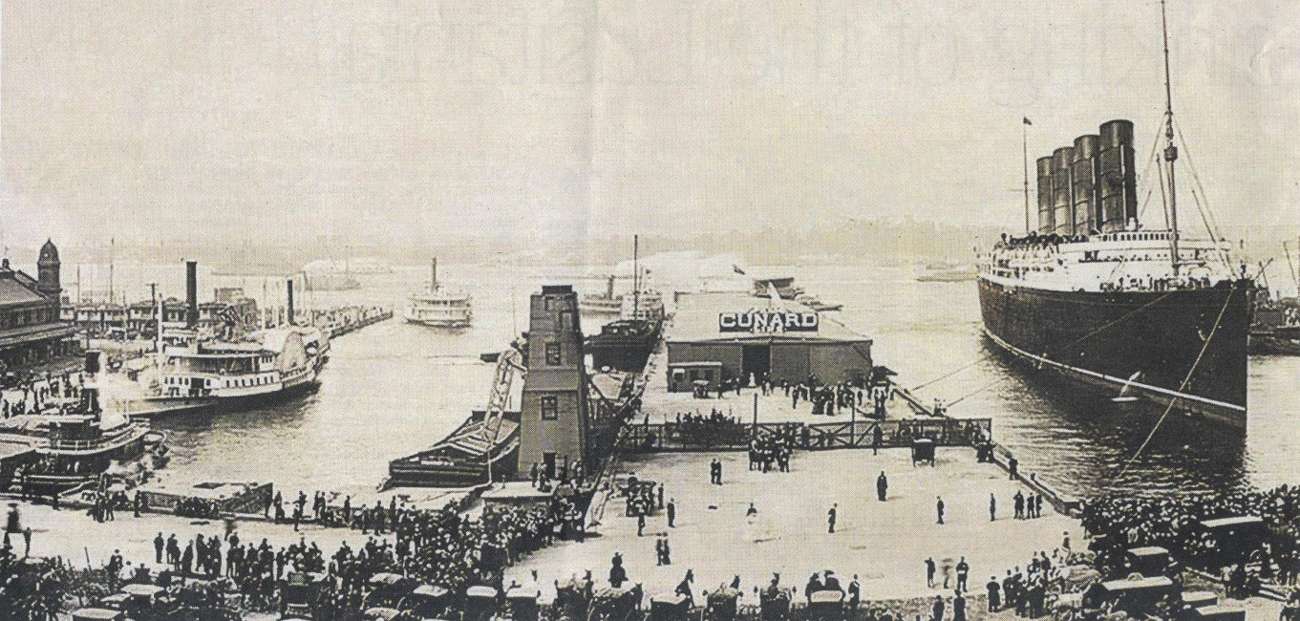
The Lusitania at New York in 1907
On May 17th 1915, The Times carried this death notice: ‘On the 7th May, by the sinking of the SS Lusitania, Frank Gustavus Naumann, of ‘Redhurst’, Cranleigh, aged 61 years. Burial service on Tuesday, 18th May, at St Nicholas Church, Cranleigh at 2.45. No flowers, by request.’
Frank Gustavus Naumann was a wealthy man and international coffee trader, who had been naturalised British. He was one of the founders of the Cranleigh Freemasons’ lodge in 1910, and its first Worshipful Master.
The British transatlantic passenger liner, RMS Lusitania, of the Cunard line, a great four-funnelled vessel and one of the biggest and fastest ships in the world, was on a crossing from New York to Liverpool. The First World War, at that time called ‘The Great War’, was in its second year. German U-boats (Unterseebooten, or ‘under-sea boats’) were active in sinking military vessels in the North Atlantic. Before the Lusitania left New York, the German embassy in the U.S. issued a warning that any vessel flying the British flag (not just military vessels) was ‘liable to destruction’. Nevertheless, 1,959 passengers embarked, including Cranleigh’s Frank Naumann. After sailing for six days, and when it was only a few hours from Liverpool, a German U-boat, which had been lying in wait, launched a torpedo at it. The ship was eleven miles off the Irish coast, it was a beautiful spring day, and passengers had come on deck to admire the Old Head of Kinsale lighthouse and the wild Irish coastline. The torpedo struck the Lusitania ten feet below the waterline. The vessel keeled over, making it impossible to launch many of the lifeboats, and then reared up and sank bow first. Within 20 minutes it had vanished under the water.
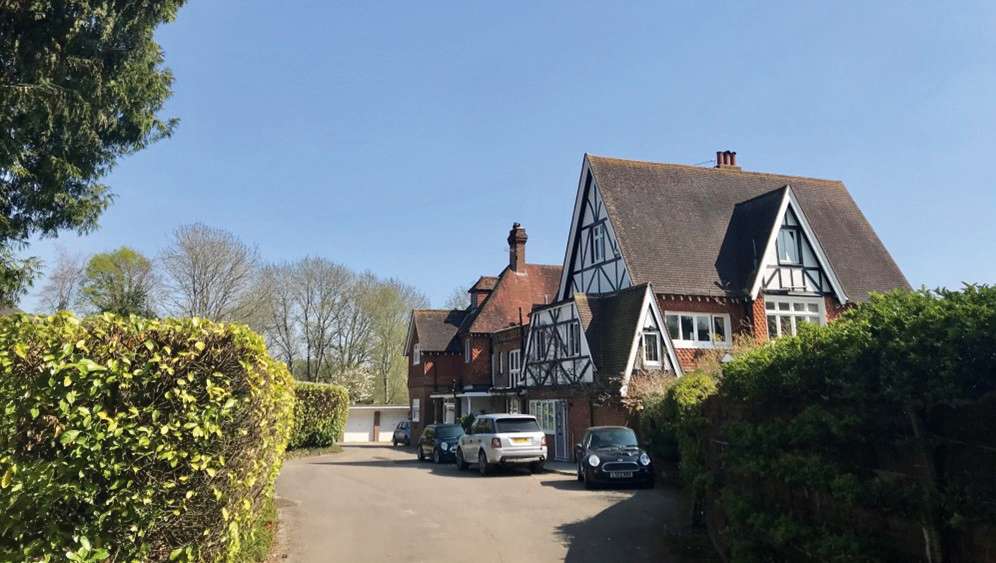
Redhurst, home of Frank Naumann, off Knowle Lane, in 2020 (courtesy of Cath George)
There were 1,198 people drowned, and only 761 survivors (precise figures vary slightly).
The sinking of a liner carrying civilians, including women and children, was without precedent and was widely denounced. The Daily Mail‘s headline screamed ‘British and American Babies Murdered by the Kaiser’. The Daily Mirror called it ‘murder’ by a ‘German pirate’, even though evidence came to light that the liner had been carrying some military supplies. A French magazine called the sinking ‘a crime’ and the Irish used it in an army recruiting drive. The Daily Sketch demanded mass internment of German residents in the U.K., with the headline ‘Lock Them All Up!’ It led to ugly demonstrations against German residents, and the burning of their businesses. Eventually 23,000 had to be interned for their own safety, many of them in holiday accommodation on the Isle of Man. Aware of the international condemnation of their action, the Germans suspended U-boat attacks on civilian vessels until February 1917, when they resumed indiscriminate submarine warfare, even on neutral vessels.
The Lusitania’s 1st-class lounge
Frank Naumann’s body was one of the 289 recovered from the sea, of which only 224 could be identified. He was cremated in Liverpool, and his ashes were brought to Cranleigh. A big funeral was held at the parish church, with all the notable gentry and principal business men attending. Many of the names will be familiar: Sir George Bonham of Knowle, Charles Chadwyck-Healey of Wyphurst, David Henderson of Vachery, William Welch of Stonewall, E.L. Rowcliffe of Hall Place, Doctors Napper, Willis and Walker, builders Frederick and Ernest Warren and H. R. Thorpe, Stephen Rowland (developer), Samuel Mann (of David Mann’s), Raymond Swallow (brick and tile maker), and many others. The Cranleigh Freemasons were represented by seven members, and representatives of the firm of Naumann, Gepp & Co attended. The hymns included ‘Nearer, my God, to Thee’ (famously sung as the Titanic sank in 1912) and ‘Now the labourer’s work is o’er’.
The rector’s daughter, Peg Cunningham, wrote later that Mrs Naumann had specifically asked that the rector should carry the urn containing the ashes to the grave, but he had not expected such a large and heavy marble one. An unmuscular man, ‘I just stuck out my tummy, balanced the urn on it, and put my arms around it.’ Sheer willpower got him to the grave safely, but he was sweating and trembling. As thanks, the widow gave him a little silver sweet dish.
Naumann’s grave in the churchyard, near the West door, was obscured by brambles for many years, until it was unearthed in about 2016. It has now been restored by the Freemasons.
Frank Naumann’s grave, with an obliging cock pheasant
The Cranleigh History Society meets on the second Thursday of each month at 8.00pm in the Band Room. The next meeting will be on Thursday September 9th, when Michael Miller will speak on ‘Postal services in Surrey’.

